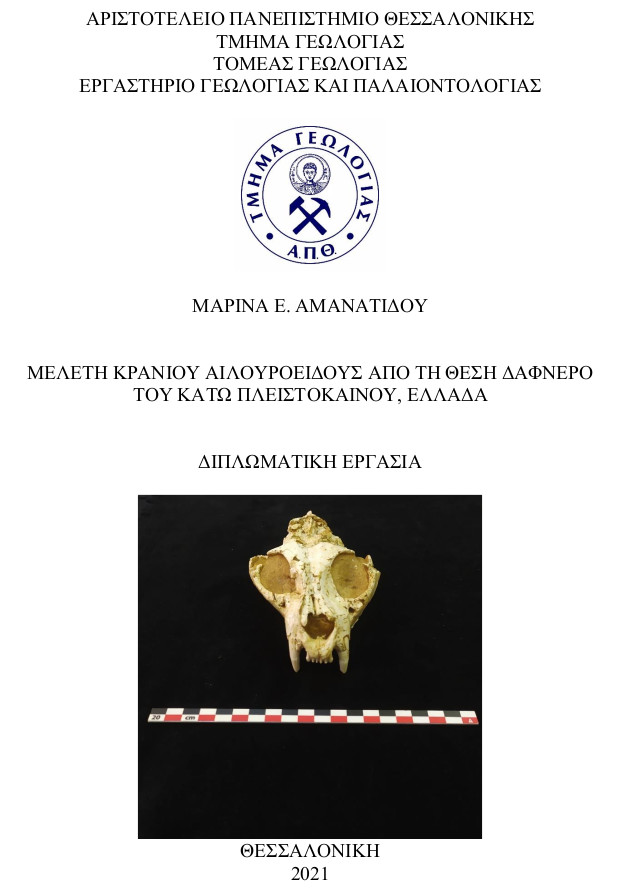
Μελέτη κρανίου αιλουροειδούς από τη θέση Δαφνερό του κάτω πλειστόκαινου, Ελλάδα = Study oa a feline cranium from thw lower pleistocene locality of Dafnero, Greece.-
Περίληψη
Το πρώτο κεφάλαιο αποτελεί το εισαγωγικό κομμάτι της διατριβής, δίνοντας σημαντικές πληροφορίες που αφορούν κυρίως τα βασικά γνωρίσματα των τριών απολιθωματοφόρων θέσεων που συντελούν το Dafnero, το ιστορικό των ανασκαφών, καθώς και το γεωλογικό υπόβαθρο της περιοχής (στρωματογραφία, γεωμορφολογία). Στην συνέχεια, εξιστορείται η εξελικτική πορεία του γένους Lynx σε όλο τον κόσμο, από την εμφάνιση του στα 4Ma μέχρι και σήμερα. Ιδιαίτερη βάση δίνεται στον κύριο πρόγονο τους γένους, τον «Λύγκα του Ισίδωρου», Lynx issiodorensis, καθώς είναι ο κύριος εκπρόσωπος του γένους στο Κάτω Πλειστόκαινo.
Στο δεύτερο κεφάλαιο παρουσιάζονται τα υλικά και οι μέθοδοι που χρησιμοποιήθηκαν για τη μελέτη του δείγματος. Το τρίτο κεφάλαιο αφορά την συστηματική ταξινόμηση του δείγματος και πιο συγκεκριμένα δίνονται οι μετρήσεις του και η περιγραφή του. Σημαντικό τμήμα της μελέτης αποτελεί και το τέταρτο κεφάλαιο, όπου του δείγμα συγκρίνεται με το σημερινό «Ευρασιατικό λύγκα» Lynx lynx, και με άλλα δείγματα Lynx από το ευρωπαϊκό Πλειστόκαινo.
Τέλος, στο πέμπτο και τελευταίo κεφάλαιo γίνεται μία ανάλυση των όσων ειπώθηκαν, και εκδίδονται συμπεράσματα για την ταξινόμηση του δείγματος, τον τρόπο ζωής του, τη συνύπαρξη του με άλλα είδη στο Δαφνερό.
In this thesis, a feline skull, possibly from a lynx species, from the greek, Early Pleistocene locality of Dafnero (Kozani) was studied.
The first chapter is an introduction providing important, basic information regarding the three fossil sites in Dafnero, the history of the excavation and the geological background of the aera (stratigraphy, geomorphology). Next, the evolution tale of the genus Lynx is told, (how it has evolved all around the globe from 4Ma until now) specifically the story of the pivotal species of the genus, the “Issoire Lynx” Lynx issiodorensis, who is the main representative of the genus in the Early Pleistocene.
In the second chapter, the materials and methods that were used in this study are presented. The following chapter is about the systematic paleontology of the specimen (biometric measurements and description of the specimen). The most important part of the study is the fourth chapter, where the specimen is compared with the extant “Eurasian Lynx” Lynx lynx, as well as with other Pleistocene Lynx specimens from Europe.
Finally, in fifth and last chapter of this thesis the conclusions of this study are presented (the taxonomy of the specimen, how it coexisted with the other species of Dafnero etc.).
Πλήρες Κείμενο:
PDFΑναφορές
Benammi M., Aidona E., Merceron G., Koufos G., Kostopoulos D., 2021. Magnetostratigraphy and Chronology of the Lower Pleistocene Primate Bearing Dafnero Fossil Site, N. Greece, Quaternary 2020, 3, 22.
Cherin M., Iurino D.A., Sardella R., 2013, New well-preserved material of Lynx issiodorensis valdarnensis (Felidae, Mammalia) from the Early Pleistocene of Pantalla (central Italy), Boll. Soc. Paleontol. Ital., 52 (2013), pp. 103-111.
Ghezzo E., Boscaini A., Madurell-Malapeira J., Rook L., 2014. Lynx remains from the Pleistocene of Valdemino cave (Savona, Northwestern Italy), and the oldest occurrence of Lynx spelaeus (Carnivora, Felidae), Rendiconti Lincei, 26 (2015), pp. 87-95.
Gomerčić T., Sindičić M., Duras Gomerčić M., Gužvica G., Frković A., Pavlović D., Kusak J., Galov A., Huber D., 2010,
Cranial morphometry of the Eurasian lynx (Lynx lynx) from Croatia, Vet. Arh., 80 (2010), pp. 393-410.
Kargopoulos N., 2019, Carnivoran Dietary Adaptations, a multiproxy study on the feeding ecology of the fossil carnivorans of Greece, MSc Thesis National and Kapodistrian University of Athens, pp. 73-73.
Kostopoulos D.S., Guy F., Kynigopoulou Z., Koufos G.D., Valentin X., Merceron G., 2018. A 2Ma old baboon-like monkey from Northern Greece and new evidence to support the Paradolichopithecus-Procynocephalus synonymy (Primates: Cercopithecidae), Journal of Human Evolution 121 (2018) 178 – 192.
Koufos G.D., Kostopoulos D.S., Kolliadimou K., 1991. A new mammalian locality in the Villafragnchian of western Macedonia (Greece) C. R. Acad. Sci. Paris, t. 313: 831 - 836.
Koufos G.D., 2014. The Villafranchian carnivoran guild of Greece: implications for the fauna, biochronology and paleoecology, Integrative Zoology, 9(4), 444–460.
Kurten B., 1978. The Lynx from Etouaires, Lynx issiodorensis (Croizet & Jobert), late Pliocene, Annales Zoologici Fennici, 1978, Vol.15 No. 4 (1978), pp. 314-322.
Kurten B., Werdelin L., 1984. The relationships of Lynx shanius Teilhard, Annales Zoologici Fennici, 1984, Vol.21, No. 2 (1984), pp. 129-133.
Mecozzi B., Sardella R., Boscaini A., Cherin M., Costeur L., Madurell-Malapeira J., Pavia M., Profico A., Iourino D. A., 2021.The tale of the short tailed cat: New outstanding Late Pleistocene fossils of Lynx pardinus from southern Italy, Quaternary Science Reviews 262 (2021) 106840.
Meloro C., 2011. Feeding habits of Plio-Pleistocene large carnivores as revelead by the mandibular geometry, Journal of Vertebrate Paleontology, Vol. 31 No.2, pp. 428-446.
Van Valkenburgh B., Damuth J., MacFadden B.J., 1990. Skeletal and dental predictors of body mass in carnivores. In Estimation and Biological Implications Body Size in Mammalian Paleobiology, Cambridge University Press, Cambridge etc (1990), pp. 181-205
Von den Driesch A., 1976. A guide to the measurement of animal bones from archaeological sites, Peabody Museum of Archaelogy and Ethnology, University of Harvard, pp 47-49.
Wederlin L.,1981. The evolution of lynxes, Annales Zoologici Fennici, Vol. 18, No.1 (1981), pp 37-71.
Ηλεκτρονικές πηγές:
https://www.callisto.gr/lygkas
Εισερχόμενη Αναφορά
- Δεν υπάρχουν προς το παρόν εισερχόμενες αναφορές.
